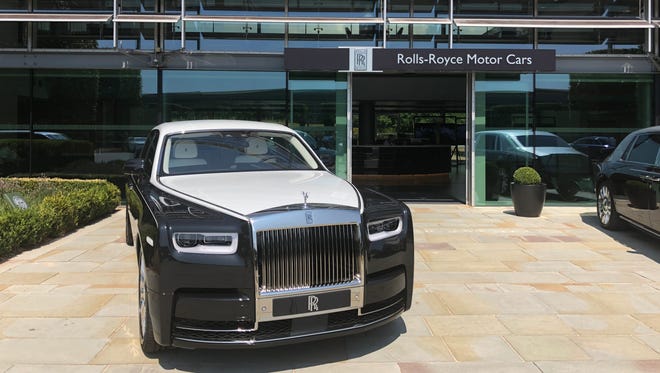In rough times, Rolls-Royce seeks a smooth ride
 Jane Onyanga-Omara
Jane Onyanga-Omara
Corrections & Clarifications: A previous version of this story misstated the state in the United States where Rolls-Royce cars were once built.
GOODWOOD, England – In the rolling southern English countryside, close to the cathedral city of Chichester, a one-of-a-kind building looms just past an unassuming roundabout: the House of Rolls-Royce, the only place in the world where the luxury vehicles are made.
All the components of the cars are made at the factory here in Goodwood, except for the engines and frames, the firm says. There are about 1,800 employees of almost 50 nationalities here, from the design team to the engineers and communications staff.
The luxury goods firm, now owned by Germany's BMW, makes about 4,000 vehicles a year. The Phantom, with a retail price of about $500,000, is the flagship, while the current bestseller is the Dawn, a convertible with a folding roof. The Cullinan, the brand's SUV, launched in May as the newest addition to the fleet. The first customers will receive their vehicles early next year.

The United States is Roll-Royce's largest export market, followed by China. Last year, about one-third of all commissions last year were for customers in North America, including Canada. The cars have a waiting time of five months to a year.
Despite Britain’s exit from the European Union in March next year and President Donald Trump's talk of tariffs on cars imported from the EU, “it is business as usual at Rolls-Royce Motor Cars,” Rolls-Royce spokeswoman Emma Rickett says.
Indeed, last month the firm said there had been a 13 percent rise in global sales of its vehicles this year, compared with the same period in 2017.
“This is a very encouraging half-year result. "It is a testament to our incredibly skilled and dedicated team at Goodwood, and underlines the trust and loyalty of our customers worldwide,” CEO Torsten Müller-Ötvös said in a statement.

Attention to detail is paramount in making the custom vehicles, no two exactly the same. One employee, Mark Court, draws lines on the sides of the vehicles using a self-designed brush made from squirrel hairs to get the finest possible detail. He is flown around the world to custom-paint designs, including tigers and pet dogs, and has a team of apprentices.

The firm prides itself on its apprenticeship program. Despite being a storied brand, It has a young workforce with an average age of about 34, 80 percent of whom are from the local area.
They have mastered talents such as sewing fiber optics into the interior roofs that replicate the look of stars and constellations at night. Leather from Alpine cattle – less likely to have damaged hides from crashing into barbed-wire fences – is used for the trim. Bulls are preferred because the cows get stretch marks due to pregnancy. The cars are tested for durability in extreme conditions around the world, from the deserts of the United Arab Emirates to the bitter cold of the Arctic Circle.

Customers have requested leather from crocodiles, ostriches and even stingrays. All the leather used must be legally sourced and is never from endangered species, the company says.
At least seven coats of paint – and as many as 22 – are applied to each car, the one area where the firm uses robots to do the work. Special touches can include a mother-of-pearl paint finish. Even ground diamonds have been added to the paint, which comes in more than 44,000 colors.

Henry Royce, a self-taught engineer, was born in 1863 near Peterborough in England, working for a railway company and tool-making firm before setting up a business making dynamos and electric cranes. He became interested in cars and had built three of his own by 1904, when he was introduced to Charles Rolls, an upper-class young man who gained an interest in engineering. Rolls-Royce was born.
Rolls, who was also a pioneer in aviation, died in a plane crash at age 36. He was the first Briton to die in an aircraft accident.
Rolls-Royce Aerospace, a separate company that has become a leader in jet engines, has operations at the pair’s old car factory in Derby, northern England.
Rolls-Royce has only built its cars outside Britain once – a factory in Springfield, Massachusetts, that the firm built in 1921. There, it manufactured the Ghost and the Phantom. The factory was closed in 1931 amid the Great Depression, and all the vehicles have since been manufactured in Great Britain.
Now Rolls is thoroughly British.